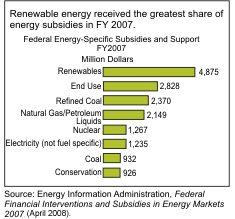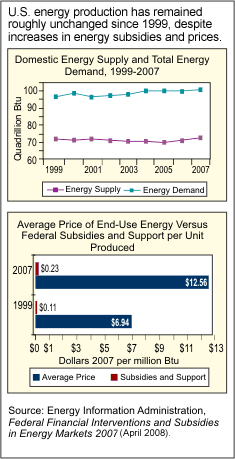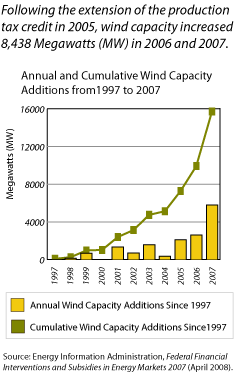
In FY 2007, most primary energy production received some type of energy-specific subsidy, as did conservation- and efficiency-related activities.1 Subsidies to renewable energy resources2 have been growing most rapidly. In FY 1999, renewable energy received $1.4 billion in subsidies. By FY 2007, subsidies to renewable energy of all forms grew to $4.9 billion. Ethanol production received $3.0 billion in blender’s credits under the Volumetric Ethanol Excise Tax Credit, exceeding any conventional or renewable fuel. Certain fossil fuels are also heavily subsidized. In FY 2007, refined coal (chemically enhanced to reduce certain emissions) received about $2.4 billion. Subsidies for refined coal are expected to decline as a result of modifications to the Internal Revenue Code that were enacted in the Energy Policy Act of 2005.
Have Subsidies Affected Prices or Production?
Between 1999 and 2007, the average real price of total energy per British thermal unit (Btu)3 consumed increased more than 80%. Meanwhile, total energy consumption or demand, including imports, grew by about 5%. Most subsidies and support to energy producers should stimulate supply; so too should higher prices and rising energy demand. Yet in 2007, the United States supplied roughly 72 quadrillion Btu from domestic resources, about the same amount as in 1999. This leaves the impression that energy subsidies had little effect on net domestic production other than to help prevent further declines. But the enactment of various production-oriented tax incentives in the Energy Policy Act of 2005 and subsequent legislation may have contributed to the slight increase in primary energy production over the last two years.
Some portion of production-related subsidies may result in one primary energy source being substituted for another. Between 1999 and 2007, the only primary energy source for which production increased every year was wind power. Over this period, the Btu equivalent of electricity produced by wind increased at a yearly rate of almost 32%, compared with 0.1% per year for coal and 0.3% per year for natural gas.4 Other subsidies like loan guarantees for financing power plants require lengthy lead times: often there is a lag between the Federal government’s expenditure and commercial production. The $3.8 billion of conservation and end-use efficiency subsidies reduce energy demand and do not promote primary energy or electricity production.
How Do Federal Subsidies and Support Affect Market Behavior?
Subsidies and support can encourage producers to bring new technologies to market until manufacturers are able to produce the new technology in large quantities at costs competitive with established commercial technologies.
The periodic expiration and extension of the production tax credit (PTC) for wind power since 1992 illustrates the effect of tax incentives. Between 1997 and 2007, nearly 16,000 megawatts (MW) of wind capacity have been installed. The Energy Policy Act of 2005 extended the PTC to wind facilities placed in service before January 1, 2008. Subsequently, 8,438 MW of wind capacity was placed in service in 2006 and 2007.
There are several alternative ways to compare subsidies across fuels. In FY 2007, wind power received subsidies and support valued at $23.37 per megawatthour (MWh). Refined coal and solar had even higher subsidies per MWh produced. The estimated subsidies for traditional primary energy sources used for electricity production were significant in total dollars. It is estimated that coal received $854 million, nuclear received $1,267 million, and natural gas and petroleum liquids received $227 million. However, these traditional forms of generation produce most of the Nation’s electricity, resulting in subsidies and support per unit of production of between $0.25 and $1.69 per megawatthour.
Up to now, the PTC has been a significant factor in encouraging wind capacity. In the future, other factors will also influence the decision to build wind capacity. Twenty-seven States have adopted mandatory renewable portfolio standards requiring that 4% to 25% of electricity sales be provided from renewables by certain dates ranging from 2009 to 2025. Technological improvements resulting in larger wind turbines, as well as higher prices for fossil fuels used in traditional generation, should enhance the financial feasibility of wind power.
Rankings of subsidies and support based on absolute amount and amounts per megawatthour of generation differ widely, reflecting substantial differences in the amount of generation across fuels. Subsidies and Support to Electric Production by Selected Primary Energy Sources |
|||
| Primary Energy Source | FY 2007 Net Generation (billion kilowatthours) | Subsidies and Support Allocated to Electric Generation (million FY 2007 dollars) | Subsidies and Support per Unit of Production (dollars/megawatthour) |
| Natural Gas and Petroleum Liquids | 919 | 227 | 0.25 |
| Coal | 1,946 | 854 | 0.44 |
| Hydroelectric | 258 | 174 | 0.67 |
| Biomass | 40 | 36 | 0.89 |
| Geothermal | 15 | 14 | 0.92 |
| Nuclear | 794 | 1,267 | 1.59 |
| Wind | 31 | 724 | 23.37 |
| Solar | 1 | 174 | 24.34 |
| Refined Coal | 72 | 2,156 | 29.81 |
| Energy Information Administration, Federal Financial Interventions and Subsidies in Energy Markets 2007, SR/CNEAF/2008-1 (Washington, DC, 2008). | |||
1 In addition to benefitting from the energy-specific subsidy and support programs considered in this brief, energy activities may also benefit from subsidies and programs available to a broad range of energy and non-energy sectors.
2Renewable energy resources are energy resources that are naturally replenishing but flow-limited. They are virtually inexhaustible in duration but limited in the amount of energy that is available per unit of time. Renewable energy resources include biomass, hydropower, geothermal, solar, wind, ocean thermal, wave action, and tidal action
3A Btu equals the quantity of heat required to raise the temperature of 1 pound of liquid water by 1 degree Fahrenheit at the temperature at which water has its greatest density (approximately 39 degrees Fahrenheit).
4Energy Information Administration, Monthly Energy Review, May 2008, Tables 1.2, DOE/EIA-0035(200805) (Washington, DC, May 2008).



